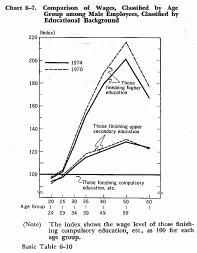| Home > Policy > White Paper, Notice, Announcement > White Paper > EDUCATIONAL STANDARDS IN JAPAN 1975 > CHAPTER6 1 (4) | ||
While the number of students going on to upper secondary schools, universities and junior colleges has been in consistent growth in recent years, how are the graduates of these schools treated in their respective places of work?

The wage gap among the employed (male), classified by educational background, is shown in indices in Chart 6-7, with the wage level of compulsory education school graduates as 100.
Both in 1970 and 1974, the wage gap between those with different levels of educational background is not very wide among young employees, but gradually widens among those over 30 years of age. Yet, if the trends of these two years ard compared, the wage gap ascribable to the difference in educational background may be said to be shrinking year by year. This same tendency, as described above, applies also to the starting salary of the newly employed, classified by educational background, as shown in Table 6-4.

| Back to Top | MEXT HOME |